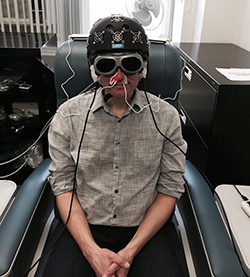Public Health
Research Spotlight: Can Light Therapy Help the Brain?


A staffer in Dr. Margaret Naeser’s lab demonstrates
the equipment built especially for the research: an
LED helmet (Photomedex), intranasal diodes
(Vielight), and LED cluster heads placed on the
ears (MedX Health). Goggles are worn to block out
the red light. The near-infrared light is beyond the
visible spectrum and cannot be seen.
(Photo courtesy of Naeser lab)
Following up on promising results from pilot work, researchers at the VA Boston Healthcare System are testing the effects of light therapy on brain function in Veterans with Gulf War Illness.
Veterans in the study wear a helmet lined with light-emitting diodes (LEDs) that apply red and near-infrared light to the scalp. They also have diodes placed in their nostrils, to deliver photons to the deeper parts of the brain.
The light is painless and generates no heat. A treatment takes about 30 minutes.
The therapy, though still considered "investigational" and not covered by most health insurance plans, is already used by some alternative medicine practitioners to treat wounds and pain. The light from the diodes has been shown to boost the output of nitric oxide near where the LEDs are placed, which improves blood flow in that location.
"We are applying a technology that's been around for a while," says lead investigator Dr. Margaret Naeser, "but it's always been used on the body, for wound healing and to treat muscle aches and pains, and joint problems. We're starting to use it on the brain."
Naeser is a research linguist and speech pathologist for the Boston VA, and a research professor of neurology at Boston University School of Medicine. She is also a licensed acupuncturist and has conducted past research on laser acupuncture to treat paralysis in stroke and pain in carpal tunnel syndrome.
How do the diodes work?
The LED therapy increases blood flow in the brain, as shown on MRI scans. It also appears to have an effect on damaged brain cells, specifically on their mitochondria. These are bean-shaped subunits within the cell that put out energy in the form of a chemical known as ATP. The red and near-infrared light photons penetrate through the skull and into brain cells and spur the mitochondria to produce more ATP. That can mean clearer, sharper thinking, says Naeser.
Naeser says brain damage caused by explosions, or exposure to pesticides or other neurotoxins—such as in the Gulf War—could impair the mitochondria in cells. She believes light therapy can be a valuable adjunct to standard cognitive rehabilitation, which typically involves "exercising" the brain in various ways to take advantage of brain plasticity and forge new neural networks.
"The light-emitting diodes add something beyond what's currently available with cognitive rehabilitation therapy," says Naeser. "That's a very important therapy, but patients can go only so far with it. And in fact, most of the traumatic brain injury and PTSD cases that we've helped so far with LEDs on the head have been through cognitive rehabilitation therapy. These people still showed additional progress after the LED treatments. It's likely a combination of both methods would produce the best results."
Naeser hopes the work will validate LED therapy as a viable treatment for Veterans and others with brain difficulties. She foresees potential not only for war injuries but for conditions such as depression, stroke, dementia, and even autism.
This article originally appeared in VA Research Currents on March 31, 2015. To view the full article or subscribe to VA research updates, please visit www.research.va.gov/currents/default.cfm.
Make a Difference: Participate in Gulf War Research
VA is a national leader in health research. Each year, dedicated researchers and volunteers work together on thousands of studies to advance medical care for future Veterans. In addition to the spotlighted LED study, there are many more projects needing volunteers. Several VA studies recruiting participants are listed below.
- Impact of Exercise Training on Pain and Brain Function in Gulf War Veterans
- Complementary and Alternative Medicine in Veterans with Gulf War Illnesses
- Vascular and Skeletal Muscle Function in Gulf War Veterans’ Illness
- Complementary Neurosteroid Intervention in Gulf War Veterans’ Illnesses
- Randomized Clinical Trial of Duloxetine and Pregabalin for the Treatment of Gulf War Illness in Veterans
For more information about VA research or to volunteer for a study, please visit www.research.va.gov, or www.warrelatedillness.va.gov/research/volunteer.




















